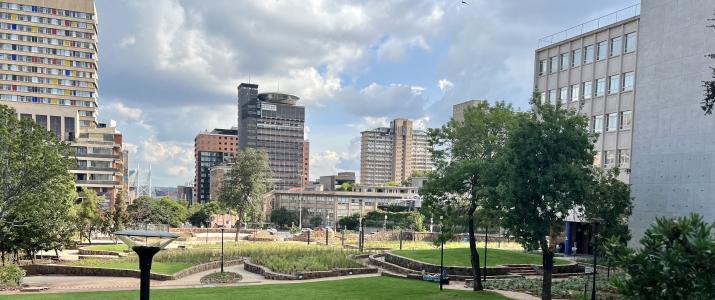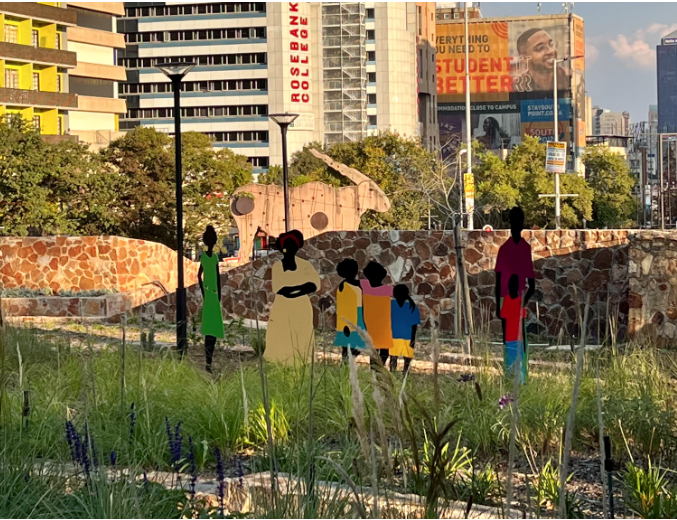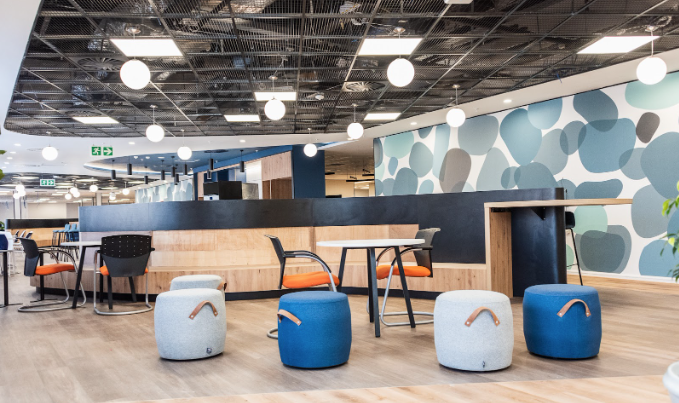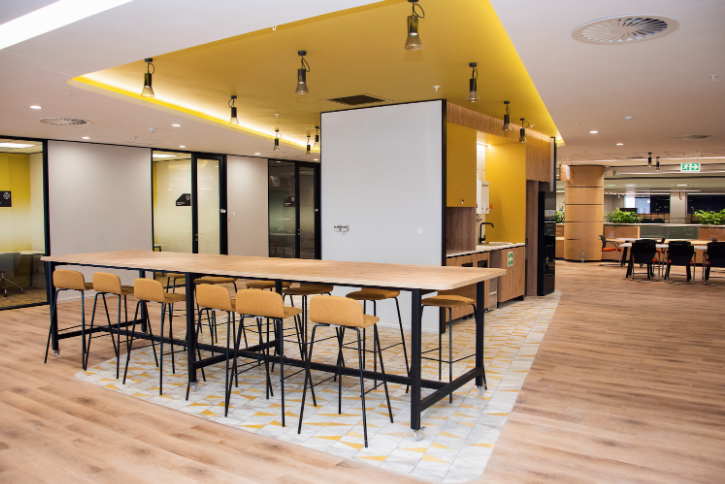
The greatest artists transform their traumatic experiences into inspiration for creating new art works. In a similar vein, the management of the Liberty Group turned the tragedy of the Covid pandemic and lockdowns into something positive, by asking themselves this key question: how do we respond to the evolution of work in a way that inspires our employees, partners and clients and leaves a living legacy in Braamfontein?
The answer was to transform its head office – both inside and outside – to create a meaningful space that fosters human connection and the holistic wellbeing of its employees and the communities Liberty services. As one of Braamfontein’s oldest tenants (it’s been there since 1957) it feels a duty to drive new ideas within this space.
Indwe Park
The Liberty Indwe park project was developed by Liberty Two Degrees, a subsidiary of Liberty, headed up by Amelia Beattie as Chief Executive. The park took two years to build and involved a whole team of creatives. The four-hectare garden directly opposite Wits University encompasses the precinct of Liberty’s headquarters and the building near Jan Smuts that once housed South African Breweries, which is now an innovation centre. The Park is an intended Braamfontein landmark, and therefore a national legacy.
Indwe, derived from isiXhosa and Zulu, is the name for our national bird, the blue crane. The park is an intentionally created healing space that includes an “earthing mound” where you can get in direct contact with the earth, reflexology sections with uneven stone surfaces, soft, gorgeous landscaping, a stunning “compass” mosaic that directs visitors to the area’s landmarks, and indigenous and medicinal plants. Liberty employees, who once looked out onto a car park, can now engage with nature right on their office doorstep.

“Our purpose was to create experiential spaces and as we went into the hard lockdown in 2020, for us as the Group, it gave us an opportunity to think about creating something that meets that objective and that would have a lasting impression and impact on Liberty's people, as well as provide a reason for people to return to an environment where great things were born over many years,” says Amelia.
“With environmental sustainability as a core area in our business, we had the opportunity to develop a space that created a ‘green lung’ in the city and that adds meaning and provides fulfilment of use to the area; a place where employees, clients of Liberty and people in the surroundings can connect with nature. We had the opportunity to create something that didn’t previously exist – an outside space which engages with the environment,” she adds.
“The park is an opportunity to create a space where we can serve the people of the organisation, as well as connect with the city and the broader Braamfontein community,” adds Nev Lalloo, Divisional Executive at Liberty's Group Real Estate Services.
The design of the park incorporates Liberty’s human-centric approach to empowering employees, clients and its adviser partners – and, by extension, the students and inner-city residents, who will also be able to engage and enjoy this feature for generations to come.
The Group aligns its offering of the park with mounting empirical evidence showing that with naturally lit, green, wellness spaces, productivity improves – and so does employee work satisfaction and wellbeing.
Workplace transformation
The park forms part of a bigger campus upgrade that Liberty has undertaken, which includes the office interior, which has been radically re-imagined and transformed into neighborhood activity-based workspaces.

Pumeza Bam, Liberty Group Executive for Human Capital, says that Covid forced companies to reimagine their old ways of working and embrace future-fit working environments that bring out the best in their employees. As the pandemic lifted, organisations began to notice that although their workers definitely did not miss commuting, many missed their offices, as they provide collaboration, social interaction and learning.
Liberty undertook a raft of research to understand its employees’ needs and perspectives, and its process of evidence-based design revealed that people want to work where they feel most productive, comfortable, and healthy – whether this is at home or in the office.

A hybrid working model, with human connection at its heart, was adopted: employees can choose to work from home or at the office, and a new, attractive office environment with a mix of private and collaborative spaces was created. In addition to ‘traditional’ work spaces, there are meeting rooms, collaboration areas, private zones, mothers’ rooms for breast-feeding, child facilities, a fabulous canteen and telephone booths, all of which, together with regular social functions, create a ‘neighbourhood’ working ethos and atmosphere.
Liberty’s real estate team studied contemporary international trends to create these spaces, designed for maximum employee stimulation, satisfaction and wellbeing. It’s definitely something that all of today’s employees should consider. As Nev shared: “If property owners and occupiers do not embrace the reality of the evolution created by hybrid working, they risk falling behind in creating a competitive advantage through their real estate portfolios.”
– Derek Davey